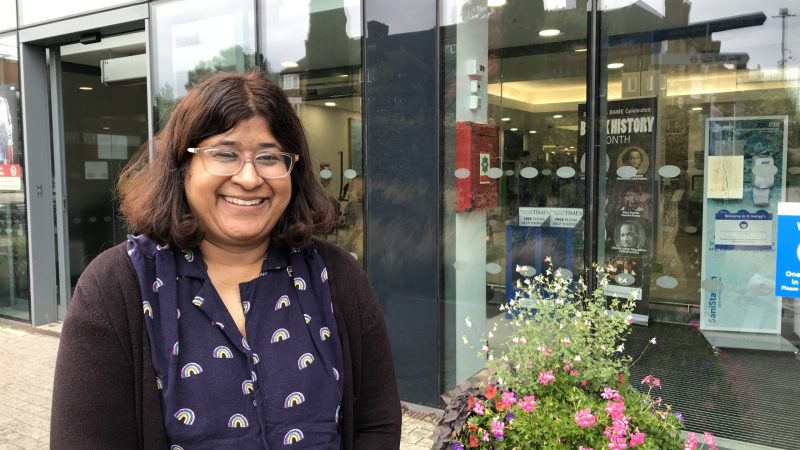Part fixer, part go-between, part … detective, patient discharge facilitator Georgina Arnold (pictured below) helps get people out of hospital when they’re well enough to go home – which is better for them.
Georgina’s is one of three roles created in April at St George’s Hospital, Tooting, to speed up the discharge of medically-fit patients and build bridges with ward staff.
“I’m the person who can liaise with everyone,” she says. “Any hold-ups can get worked on quickly, because I have time to follow up, to find the right person”. That ‘right person’ could be from any local health and care organisation, not just the hospital – a care home, GP practice or the local council’s social care team.

“We help staff on the wards get things done. They trust us and rely on us more and more,” Georgina explains. “If a patient needs a blood test, or medication to go home, we filter out all the admin, to move things along more quickly. It could be an MRI scan, an x-ray, or a meeting with a medical team. Sometimes it’s as simple as booking transport.”
A typical day for Georgina begins on the wards. “We find out what’s going on with each patient. There’s a big board with everyone’s name and what they are waiting for. This means we can start putting things in place, even before people are medically fit.”
Transfer of care hub
Georgina works closely with the hospital’s transfer of care hub, which opened last December. It was set up to tackle winter pressures, but those pressures continued as the year progressed. Specialist nurse, Marie Louis (main picture), who is based in the hub, explains: “It was only meant to be for three months, but we’re still here! In most cases, discharges can be handled by nurses on the wards but there are some complex issues – so we step in.”
Since the hub’s launch the amount of lost bed days has reduced from 300 to 150, meaning patients wait less time to leave once they are ready, boosting morale among staff.
Says Marie: “Keeping people in hospital isn’t the answer, once they are medically fit. If people stay in hospital, it’s been shown they take longer to get back on their feet, and they’re also at risk of infections. But some patients can remain here for a long time.
Getting people out of hospital should be simple, but it’s just not”
“Getting people out of hospital should be simple, but it’s just not,” adds Georgina. “A lot of the delays are things we can’t control. For example, we had a person who couldn’t go home because their electricity had been cut off. They didn’t need to be in hospital, but they couldn’t be discharged in those circumstances. We had to do some digging, find a solution.”
Most of the people waiting to go home are elderly, often with dementia or other cognitive issues, who need the right social care package. But younger people can be difficult to discharge too.
“We might have a young homeless patient, who also has psychiatric problems,” says Georgina. “They have recovered physically. They can’t stay on an acute medical ward, but we can’t just ask them to leave. We work with the hospital’s homeless inclusion unit and psychiatric and social care teams to make sure the right support is in place.
Some patients need a hospital bed or an air mattress … hospital staff have gone to their home to make sure that happens”
“We have had patients with memory loss, maybe because of early onset dementia, who can’t tell us who they are, where there are from or their date of birth.” This is where the detective work comes in, as facilitators try to trace family members or assist wards to liaise with the police and other agencies.
Sometimes delays are down to the wait for a care package or for equipment to be set up at home. Says Marie, “Some patients need a hospital bed or an air mattress but have no family to wait in for the delivery. In the past hospital staff have gone to their home to make sure that happens.”
Being in hospital for a length of time can prolong discharge. Aside from the infection risk, patients start to lose their independence. Says Georgina, “When people come into hospital, their instinct is to stay in bed, but this leads to them losing muscle function. If a patient has come from residential care, but is no longer able to walk, the home may refuse to take them back.”
Internal processes can also slow discharge. As Marie explains, the paperwork can be complex. “We need to establish whether they have capacity to agree to a placement in a nursing home, and we need to collect three days of information about them, if they are walking about at night or getting out of bed, for example. That helps decide the level of care they need and their funding. Sometimes the ward staff are too busy to complete this, but now we can do if for them.”
We build relationships with social care, with families, with wards – and that has to be a positive thing.”
It’s not uncommon for delays to come from families not being available to offer support – for example, they might be on holiday when the patient needs help to get home. But most families do what they can to make the discharge happen, taking time off work to bridge the gap before care is in place.
The arrival of the hub and facilitators like Georgina has improved communication with families. As she explains: “Sometimes nurses on wards don’t have enough time to liaise with families and social workers – because they are so busy looking after sick people. There’s a lot of waiting on hold and missed calls, which we handle for them. We build relationships with social care, with families, with wards – and that has to be a positive thing.”
